Tenkara Rods
Tenkara is the traditional Japanese method of fly-fishing, which uses only a rod, line and fly.
Tenkara are very portable telescopic rods, length from 9 to 15 ft, can collapse to 60 - 120cm, great for travel and transportation, excellent for backpacking and small to medium size stream fishing, where it's rarely necessary to cast very far. It allows getting you in hard to reach places where other rods can't with the greatest accuracy. The longer the rod the more advantage anglers get when playing fish, give you better leverage over the line and the fly. They are very lightweight and incredibly strong with very sensitive and soft action, with a very smooth curve and bending action through the entire rod.
Tenkara Rods Light 6:4 Action
Tenkara Rods Medium-Light 7:3 Action
Tenkara Rods Medium 8:2 Action
Tenkara Universal Rods
Tenkara Accessories
How to connect line to the rod?
How to extend and insert Tenkara rod?
If rod sections get stuck at a joint?
Several Top Ways to Break a Tenkara Rod
How to land a fish?
Take a good care of your rod
Tenkara fishing is a popular method of catching fish whether you fishing in freshwater or saltwater. They can be used to catch almost all fish. Catching big fish on the Tenkara rod is very challenging. They are mainly used for small-stream fishing. It is mostly effective for fishing fast flowing streams and pocket water. Tenkara rods give you total control of your tackle whilst fly fishing, allowing you to use much lighter line for very delicate presentations, provide a level of accuracy in casting. The rod allows you with better control of the fly to place your fly in exactly the spot where you want to fish, it allows you to hold the line off the water and a fly in place on the other side of a current with extreme accuracy. You can use different casting techniques, like underhand casting, snap casting, short or long casting to get the fly where you want it and the way you want it. Casting requires a slower and shorter stroke to completely turn the tippet over. A snap cast is using when changing direction of the fly without false-casting. An underhand casting is good for getting under a tree. It also allows you to land fish much quicker that with a rod and reel, one simply raises the rod high, and reaches for the fish. The simplicity, accuracy in casting and extremely light-weight are the main advantages of Tenkara fishing.
In the last few years the popularity of Tenkara fishing has grown immensely. Much of the credit for this must be given to the tackle manufacturers who using sophisticated technology to produce extremely light and strong rods made with High Modules Graphite Carbon Fiber.
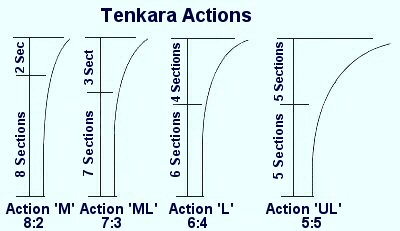
|
Tenkara rods could be comparable to most ultra-light rods used in cone pole fishing and in fly-fishing and are considered slow action, or soft action rods. Tenkara Action describes how many bottom sections are stiffer and how many tip sections are more flexible when pressure is put on the tip of the rod. It shows how much the rod can bend and how quickly it can return to its neutral position. The construction material and construction method of a rod affects the stiffness of the blank, the blankís ability to react and therefore its action.
|
| The rod action should be chosen based on the angler's preference for a softer (Ultra Light - 5:5) or slightly stiffer (6:4 or 7:3) or the stiffest (Medium - 8:2) rod. This chart compares the actions of three All Fishing Buy Tenkara rods - YOKOSHIMA-4209 (Medium 7:3 Action), WAKATA-4209 (Light 6:4 Action) and MOTSUGO-4209 (Ultra Light 5:5 Action). We hope it will help you choose the right rod to get the largest possible catch and lots of positive emotions which is just as important as positive emotions lead to longer and healthier life. |
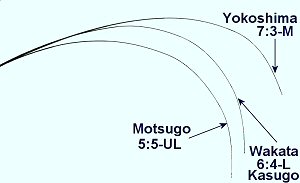
|
- 'UL' - Ultra Light - 5:5 indicates 5 bottom sections are stiffer and 5 tip sections bend more easily. Rod feel more delicate when casting because of an extra flexibility, it is great for slower casting and can hold smaller fish up to 1kg, but landing a larger fish will be more challenging using this rod.
- 'L' - Light - 6:4 means 6 bottom parts are stiffer and 4 tip sections more flexible. Rods are more sensitive and feel more precise when casting, it is great and slightly easier for a larger fish up to 2 kg.
- 'ML' - Medium Light - 7:3 indicates 7 bottom sections are stiffer and 3 tip sections more flexible. Rods are stiffer, have more precise and more powerful when casting, it is great for a larger fish up to 3kg.
- 'M' - Medium - 8:2 means 8 bottom parts are stiffer and 2 tip sections more flexible. Rods are the stiffest and fastest or are pursuing larger fish and want the rod to help them land the big fish, up to 4 kg.
You can choose the length of the rod based on the places where you will fish. Longer length allows you to fish in a wide area of the stream, on the other side of the stream or allow you to reach a longer distance without changing the fishing spot. Longer rods will give you better leverage over the line and the fly and require smaller movement by angler to set the hook for effective striking. Using a longer rod will also give you a huge advantage when playing fish, keeping it away from snags.
The line is attached directly to the tip of the rod, and tippet is attached to the end of the Tenkara line. Traditional Tenkara lines are furled, it is necessary for casting the weightless flies forward.
Back to top
How to connect line to the rod
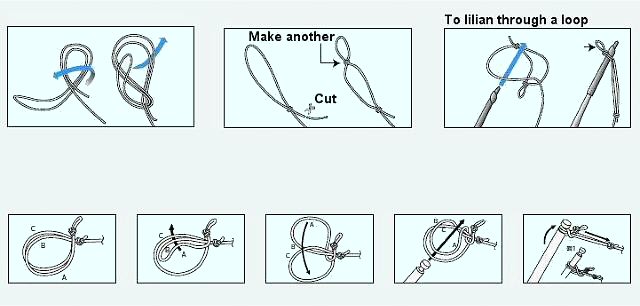
|
Next make a double knot on the fishing line.
After that put the loop over the braid lilian between the pole tip and the single overhand loop and tide the line.
Several helpful Tips
Never lift your catch, always play with the fish and use landing net to land it. Always extend and insert telescopic sections very gently, try do not extend them too forcibly, try to keep it off the ground to avoid dirt getting into the joints. Wipe it clean with a cloth before taking it down so you don't jam dirt into the joint, rinse pole with freshwater after using it in saltwater as soon as you can. Always remember to take a good care of your poles and they will work for you for a very long time and will bring you large amount of catches and a huge amount of great emotions. More great emotions - longer and healthier is your life.Back to top You should open and close telescopic rod with a special care, always keep control of the rod sections.
Tenkara rods can easily take even very heavy load, they are very strong and durable but they need to be handled with cared too. They usually don't break while fighting the fish but they could break while they are being closed without special care. Opening and closing these rods must be done very carefully and gently, no sideway pressure should be applied to the rod while closing it.
Opening Tenkara Rod.
Telescopic rods are very simple to open, but there are a couple of points to keep in mind to simplify the process and avoid damaging the rod:- Remove the plug at the end of the rod and expose the tip of the rod with a lilian string by tilting the rod a little.
- Expose the section with the braided string first and attach the line to the tip.
- Pull the tip and other sections out sliding each part between the fingers.
| Make sure to open the rod from the tip section to bottom one by one tightly and don't apply any sideway pressure, so the sections can not move when twisted. Extend each section individually and make sure it's snug but not too tight before moving on to the next section. Do not apply too much pressure when pulling sections out as that could cause pieces to get stuck. |
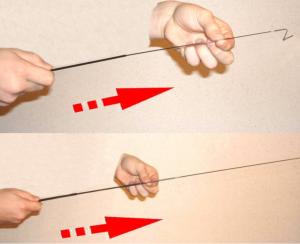
|
Once you're done shake the rod and see if you can hear any slight click signifying a "crack". If you do that means that one of the sections is not fully extended, identify it and extend it properly.
Closing Tenkara Rod.
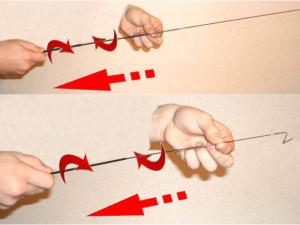
|
Telescopic rods are closed in the opposite direction, starting with the bottom section and collapsing them all the way to the tip one. It's recommended to hold each section at its thickest point of the section which is near the joint. Once again make sure not to apply any sideway pressure, use fingers, not palms, place the bottom of the rod on a flat level stable surface and push each piece in. Once the section becomes lose it will slide down. |
Back to top
If rod sections get stuck at a joint:
The most frustrating things that can happen to a telescopic fishing rod (after braking) is to become jammed at a joint. Occasionally this can happen due to dirt/mud/sand in the joint but the main cause of the joints fixed too tightly is extending the rod too forcibly.Prevention is better than cure: try do not extend the rod too forcibly, try to keep your rod off the ground at all times to avoid dirt getting into the joints. Wipe it clean with a cloth before taking it down so you don't jam dirt into the joint. If you've been using it in saltwater give it a quick rinse with freshwater as soon after use as you can. Its a good idea to put a protectant like WD-40, Tackle Guard or a silicon lube on the joints.
When it happens there are several techniques to unstick the sucker.
-
A.

|
Try to force the thinner section in by twisting them, hold the anti-sliding place near joints with the fingers and screw and press sections in reverse direction to loosen the joints but again make sure not to use sideway pressure. You might try using rubber pads to increase the grip. Always hold sections with your fingers close to joints. Have a partner hold one side of the joint while you hold the other and gently twist and press sections without using sideway pressure. Both of you hold sections with your fingers close to joints. |
C. If the hot water technique fails try the next step up. Do the same as above but put ice on the small side of the joint to shrink it. This is easiest if you get some ice from your freezer place it on a cloth or towel and then wrap that around the rod and hold it while you heat the other side with hot water.
D. Try a penetrating lubricant like WD-40, CRC or Tackle Guard. Leave the joint to soak for an hour or two and then try gently to take the rod down.
E.
| Stand the rod butt on a hard surface like concrete and hold it above the stuck joint. Gently lift and lightly tap the stuck section on the ground. This works best if the lower joints are stuck. For upper sections remove the plug of butt section, pull out the fixed two sections. Then put the rod vertically on a not-too-hard plain ground (or put towel or other soft material on the ground), hold the fixed joints and knock the ground. Never tap the tip on the ground as you are very likely to break it. You can try to combine it with a lubricant or a hot water: pour hot water on large side of the joint and lightly tap the stuck section against the bottom. Always remember to do it very gently, not to apply any sideway pressure, hold larger section with your palms and thinner section with fingers close to joints. Once the section becomes lose it will slide down. |
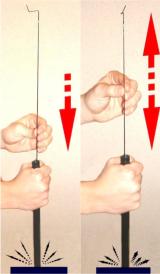
|
Back to top
Several Top Ways to Break a Tenkara Rod
Rod maintenance has nothing to do with rod breakage. Anglers will always find ways to break their rods, starting from regular (car doors) to very stupid (standing on it) or while fighting a huge fish.
One must be aware of where the rod is at all times and be especially aware of others nearby who may not see where you laid your rod. An extended rod that falls down unto the ground or other immovable object can break or be weakened by impact. 2. Slam a trunk or a car door shut with the rod stuck in it or stick the rod out the electric car window and then close the window. Always check if anything stuck from the trunk or car door or car window before closing it. Prevention is better than loss. 3. Leaning an extended rod against a car, tree, rock or any other hard surface. Striking the a rod section on an immoveable hard object will either brake it or weaken the integrity of the rod structure to the point that it later breaks under a normal load. Always lean a rod against a car with closed front doors. |
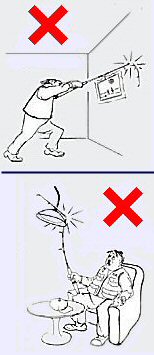
|
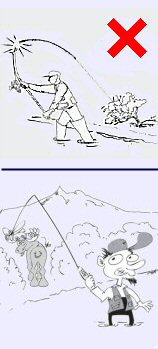
|
Allowing the tip to hit an immovable object like a tree, tree branch, or rock while moving forward or backward (backward if you carry the extended rod with the handle forward) will inevitably end in a broken tip section. 5. Casting the rod without first clearing it of overhead branches or other obstacles (like the underside of a bridge). 6. Try to free a snagged fly with the rod. Always pull on the line and never with the rod. 7. Try to remove an overhead snagged fly or line without first removing the line from a nested rod. Anytime a fly or line is stuck in an underwater snag like a submerged rock, tree branch, heavy weeds, or streamside vegetation, it should be freed by carefully grasping the line and pulling steadily while making sure there is no more than a slight bend in the rod. A snagged fly may take up to 10lbs or more steady pressure to pull free. If possible, it is best to nest the rod sections completely, detach the line from the lillian, put the rod in a safe place and then work on removing the snagged line or fly. |
Even slight pressure side to side on a partially nested tip section may cause it to snap. |

|
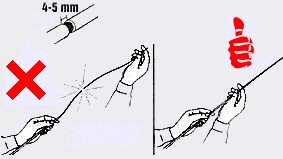
|
Anytime the rod sections are extended with great force there is a risk that one or more sections may become permanently stuck so tightly that only breakage can release them. |
11. Drag a heavy fish to the net, hand, or bank with the extended rod arced behind the fisher and not straight up. 12. Let the large fish land on the rod and break it during the struggle. An excessive rod angle (usually caused by the extended rod handle angled backward rather than straight up) will inevitably cause the weakest or most strained section of the rod to break. Beach a large fish by backing up with the rod handle in your hand held at a forward angle of no greater than 90 degrees and preferably in the 45 to 60 degree range. This includes having a guide or friend netting a fish too heavy to bring in with rod alone. After a heavy fish is sufficiently subdued, if alone, it is best to bring in a heavy fish by grabbing the line, laying the rod on the ground in a safe place, and then pulling the line in hand over hand. A really big fish can then be netted, unhooked and released or scooped onto the bank with a free hand. This particularly true of fish weighing 50 to more than 100 percent of the tippet strength. |
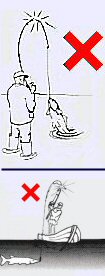
|
Back to top
How to land a fish
Needless to say that landing a small fish is very straightforward with Poles, just raise it and slide the fish into the landing net range. Catching bigger fish, fighting the large one is very enjoyable, always a challenge requiring a lot of patience and knowledge especially with the light tackle. Of course it's a lot of fun.| If you believe that you hooked a big fish, don't raise your rod, keep it low at about 45 degrees or even less to avoid breaking tip or top sections. Besides lifting the tip up will make fish fight even harder and to start swimming off at high speed. You should instead lower the rod tip angle, smoothly apply small sideway pressure, follow the movements of the fish, to a rhythm dictated by the fish, steering it away from the danger areas and trying to bring it from the bottom into open water. There is no need to hurry, take your time, let the fish get thoroughly exhausted, it will eventually come up and takes a gulp of air which is the best opportunity to smoothly slide it into your landing net. |
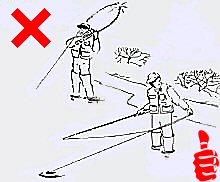
|
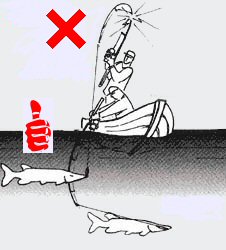
|
For really big fish make sure to bring the bottom section of the rod up to your head. Play with the fish, let it go from one direction to another, use the rod's flexibility to steer the fish in your desired direction. Making the fish swim around in different directions is the most typical method to tire it before landing it in your net.
Another technique that works with longer rods is to extend the rod all the way out past the fish so that the fish is between you and the tip of the rod. If you apply a little pressure on the line in the direction opposite to where you are, the fish will start struggling and moving towards you which is exactly what you want to happen. You might also keep the tip of the rod right above the fish to achieve the same result. |
Back to top
Take a good care of your rod.
What should or should not be done to keep our fishing tackle in good shape and ensure many years of fishing enjoyment?-
1.

|
Never lift your catch, always play with the fish and use landing net to land it. Never raise your rod high with the large fish, keep your handle angle at about 45 degrees or less. All graphite rods, are at risk of breakage if the rod is "high sticked". When the tip of the rod is raised too high, the weaker tip section bears too much of the load and can easily break. |
This is one of the most common causes of breakage and is 100% angler-caused
.2.
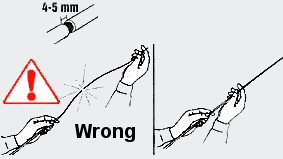
|
Always extend and insert telescopic sections very gently, try do not extend them too forcibly, try to keep it off the ground to avoid dirt getting into the joints. |

|
4. Be extra careful when getting your fishing rod out of the car, especially if it is a graphite rod. Too many people break their rod on the car door.
5.
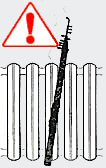
|
Don't remain the fishing rod in the back carriage of car for a long time. The long time sealed and high temperature or very low temperature conditions are harmful for fishing rod. |
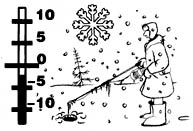
|
|
6. Always pay attention when fishing under or near the high voltage wire because of electrical shock potentiality by high voltage wire and thunder. Carbon fiber is high electricity-conductive material, so it is very dangerous if it touches electrical wire especially when you are close to the water. |
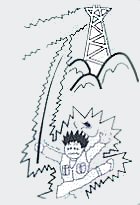
|
8. If you seal up the damp or sordid fishing rod, the moisture will possibly cause the bubbling or scaling off of lacquer. To prevent this, always rub off the moisture on fishing rod and keep it in a ventilated place. Never store a rod in its tube. Humidity can cause the moisture.
9. Always rub off the moisture, salt and dirt before storage.
| 10. Never use brush, toothpaste, gasoline, dope and other organic substances to clean the fishing rod, it may occur damage to rod surface and even the rod itself. Don't clean the rod by steel brush. You shall gently remove the dirt, any remaining "fish stuff" or salt by towel, soft brush or cloth dipped with a little soap and water, and after it is dry completely, brush up with car wax or leather. This will make it easier to clean and help preserve the rod's finish. Wiping the rod down with furniture polish after each use is a good way to keep it looking its best. |
 
|
Always remember to take a good care of your rods and they will work for you for a very long time and will bring you large amount of catches and a huge amount of great emotions. More great emotions - longer and healthier is your life.
Back to top


































